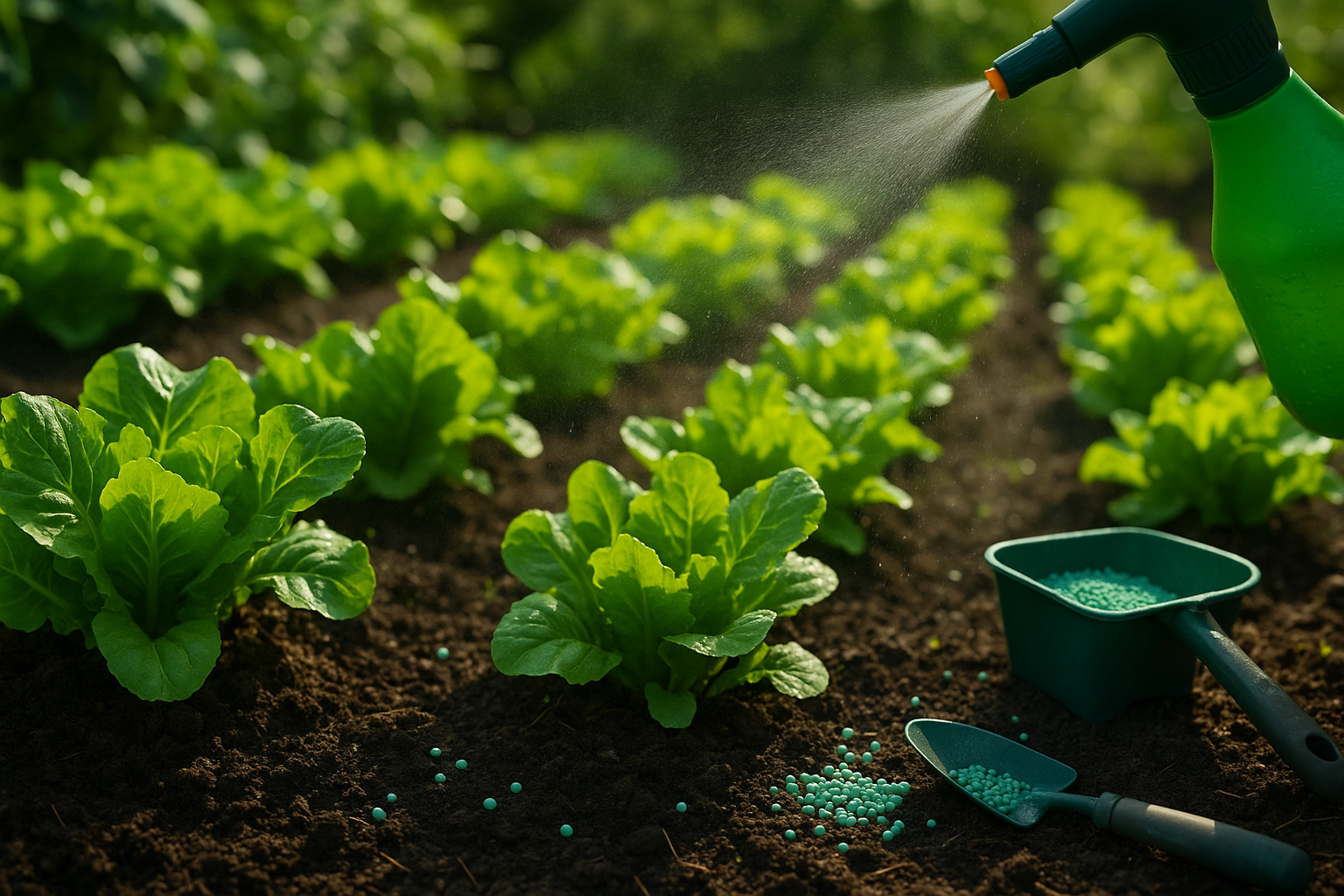Understanding Liquid and Granular Fertilizers
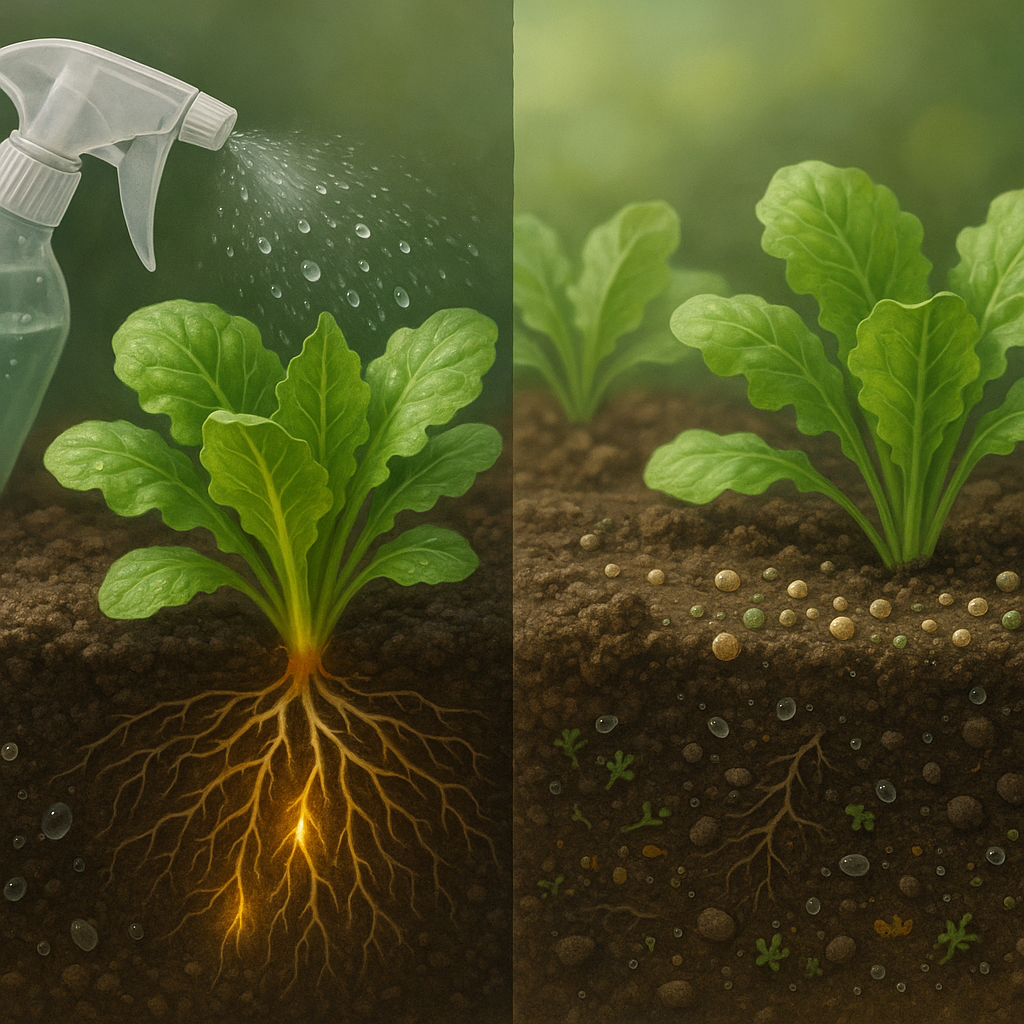
Liquid fertilizers are nutrient-rich solutions quickly absorbed by lettuce plants through their roots and sometimes their leaves. They come in concentrated bottles or pre-mixed formulations, making them easy to dilute and apply using a watering can or sprayer. Gardeners often use liquid fertilizers for fast results, as the nutrients are available almost immediately—this is especially helpful when lettuce shows signs of nutrient deficiencies or during rapid growth stages.
Granular fertilizers, on the other hand, are solid pellets or granules spread over the soil and watered in. They are designed for slow, steady release, providing a consistent supply of nutrients over several weeks. With granular fertilizers, nutrients are released as the granules break down from moisture and microbial activity in the soil, supporting lettuce from seedling to harvest without frequent reapplication.
The nutrient composition varies for both types. Liquid fertilizers usually have a well-balanced N-P-K ratio (nitrogen, phosphorus, potassium) and may include essential micronutrients, tailored for quick plant uptake. Granular fertilizers can be balanced or specialized, often featuring slow-release coatings that control how fast nutrients become available, preventing leaching and waste.
For lettuce cultivation, these differences matter because lettuce is a fast-growing, shallow-rooted crop that needs a steady nutrient supply. Quick-acting liquid fertilizers offer an early-season boost or real-time correction of deficiencies, while granular options provide long-lasting support—ideal for gardeners who prefer fewer applications. Choosing the right type—or even combining both—can lead to healthier lettuce with crisp leaves and strong growth, maximizing your gardening efforts.
Key Differences Between Liquid and Granular Fertilizers
When choosing between liquid and granular fertilizers, understanding their key differences can help you achieve the best results for your plants—especially if you’re growing shallow-rooted crops like lettuce.
One major distinction lies in how quickly they release nutrients. Liquid fertilizers deliver nutrients almost instantly because they dissolve in water, making them immediately available to plant roots. This fast action is ideal for crops that need a quick nutrient boost. Granular formulas, on the other hand, release nutrients slowly as they break down over time, providing consistent feeding but with a delayed effect.
For shallow-rooted plants like lettuce, quick-access nutrients from liquids improve absorption efficiency; their fine roots rapidly absorb what’s available in the soil solution, making every watering count. Granular fertilizers can still be effective for lettuce but may take longer to show visible results, and there’s a risk of uneven distribution if not applied carefully.
Practical Considerations
From a practical standpoint, liquid fertilizers are easy to apply with a watering can or hose-end sprayer, but they often require precise measuring and mixing with water. They must also be reapplied frequently because they wash out with each watering. Additionally, liquid fertilizers tend to have a shorter shelf life—once opened or diluted, most should be used quickly.
Granular products, in contrast, are much longer-lasting, both in the soil and in storage. They’re often simpler to store, don’t require special preparation, and can be sprinkled by hand or with a spreader. However, they need moisture to activate, which can be a challenge in dry weather. Overapplication may create hot spots that burn tender crops.
Which Fertilizer Is Best?
Ultimately, the best choice depends on your specific gardening needs. For lettuce and other shallow-rooted veggies, liquids often lead to faster, more efficient growth, while granules provide a low-maintenance, slow-and-steady feeding solution.
Pros and Cons of Liquid Fertilizers for Lettuce
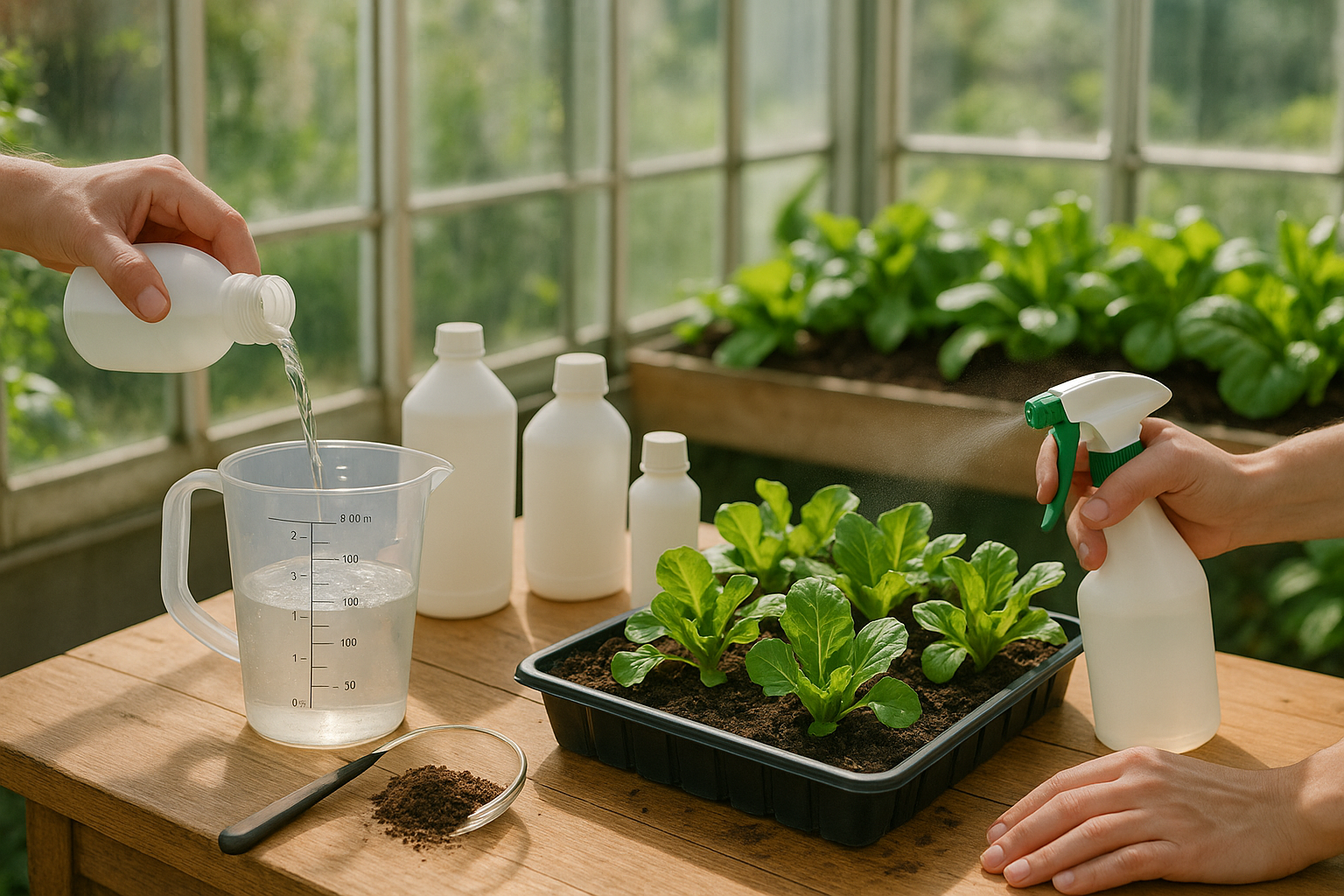
Liquid fertilizers offer several advantages when growing lettuce, making them a popular choice for many gardeners and commercial growers. One of the main benefits is their rapid nutrient availability—since the nutrients are already dissolved, lettuce plants can quickly absorb them, promoting fast and healthy growth. This is especially helpful for young seedlings or transplants that need a quick boost to establish themselves.
Liquid fertilizers are also easy to apply, whether using a watering can, hose-end sprayer, or even drip irrigation systems. This allows for even distribution and less hassle. They work particularly well as a foliar feed sprayed directly onto the leaves, which helps plants recover from stress or nutrient deficiencies within a matter of days.
However, there are some drawbacks to consider. Because liquid fertilizers act quickly, they also deplete quickly, requiring more frequent applications compared to slow-release granular options. This means extra time, effort, and cost throughout the growing season. Additionally, improper application or heavy rainfall can result in nutrient runoff, wasting fertilizer and potentially contributing to environmental pollution.
If you’re short on time or prefer a set-it-and-forget-it approach, liquid fertilizers may not be ideal. Still, they shine in scenarios where lettuce needs quick access to nutrients—such as during early growth stages, after transplanting, or when plants show visible signs of deficiency.
To get the most out of liquid fertilizers, consider pairing them with sustainable practices like soil testing and careful measuring to avoid overfeeding and runoff.
Pros and Cons of Granular Fertilizers for Lettuce
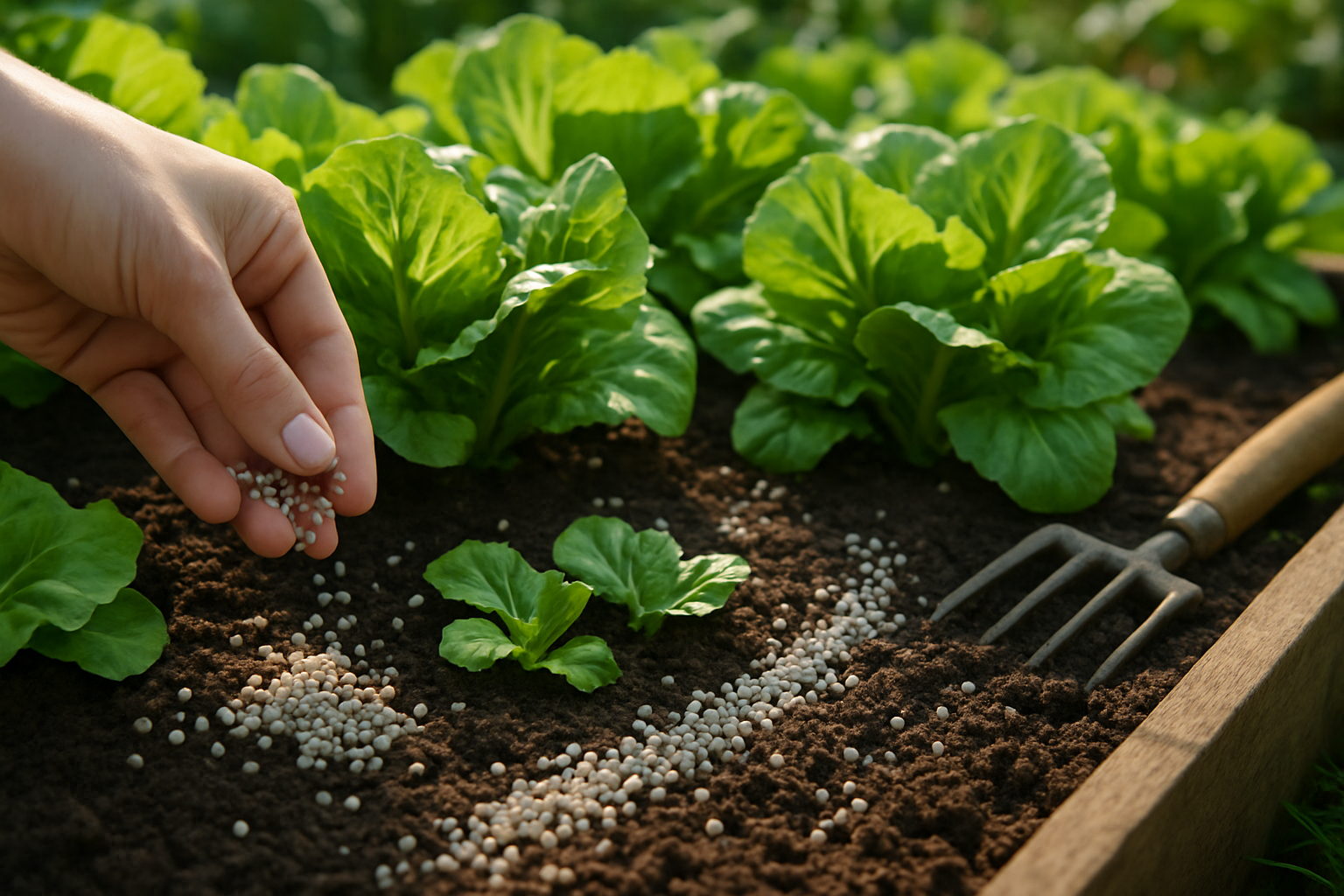
Granular fertilizers offer several compelling benefits for lettuce growers, especially those managing larger beds or looking for a low-maintenance option. One standout advantage is their slow-release formulation, which delivers nutrients over an extended period. This means you don’t have to fertilize your lettuce as often, reducing routine workload and lowering the risk of nutrient leaching from heavy watering or rain. For example, a single application at planting time can support healthy growth through much of the early development phase.
However, granular fertilizers aren’t without drawbacks. Over-application or placing granules too close to the plant base can cause root burn, a common issue that shows up as wilting or browning leaves. It’s easy to misjudge the dosage, especially for beginners, and uneven spreading might leave some lettuce plants underfed while others receive too much.
To avoid these pitfalls, it’s important to measure carefully and consider using a hand spreader for more even coverage. Granular fertilizers work best early in the growing cycle—right after transplanting or when direct-seeded plants develop their first true leaves. This provides a steady nutrient supply as roots establish. For intensive salad gardens or quick-turnover plantings, you might opt for a half-strength side-dressing midway through growth, but always follow product recommendations.
Ultimately, granular fertilizers excel when you want convenience and consistent feeding, but mindful application is key to healthy, productive lettuce.
Application Methods
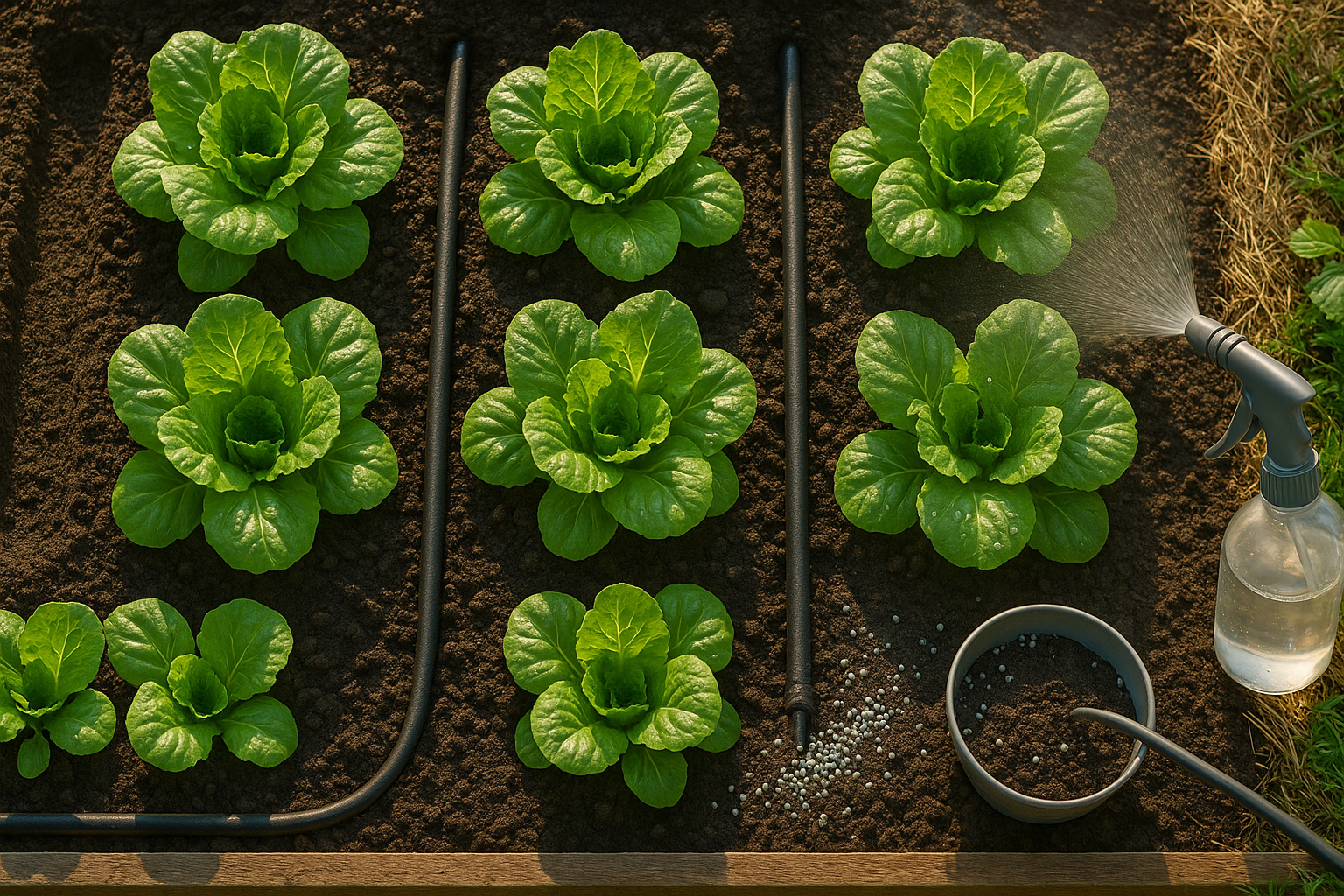
When it comes to fertilizing lettuce, choosing the right application method can make a big difference in both yield and plant health. For granular fertilizers—often synthetic or pelletized organics—broadcasting evenly over the soil before planting ensures nutrients are available throughout the root zone. To avoid patchy growth, use a hand-held spreader and mix the fertilizer into the top few inches of soil with a rake.
During the growing season, side-dressing is a great way to give lettuce a nutrient boost. Simply create shallow furrows a few inches from the rows, sprinkle in your chosen fertilizer, and cover lightly with soil. This keeps nutrients away from direct contact with tender roots, minimizing the risk of burning.
Fertigation—applying water-soluble fertilizers through drip irrigation or watering cans—is especially effective for quick nutrient uptake. Be sure to use diluted solutions and monitor for salt buildup, particularly with synthetic fertilizers.
For a fast pick-me-up, foliar sprays can be used, especially with organic solutions like fish emulsion or seaweed extracts. Spray the leaves in the early morning or late afternoon to reduce evaporation, and avoid over-applying to prevent leaf burn or runoff.
With synthetic fertilizers, precise measurement is critical to prevent overdosing, while organic products are generally more forgiving but can be less concentrated, requiring more frequent applications. Whichever method you choose, aim for even, light coverage and adjust based on the specific needs of your lettuce variety and your local soil conditions.
Which Fertilizer Is Right for Your Lettuce Crop?
Choosing the right fertilizer for your lettuce crop depends on a few key factors, such as soil characteristics, garden size, available time, and your budget. Start by testing your soil—lettuce thrives in nitrogen-rich soils, but over-fertilizing can cause leafy growth without flavor. Knowing your baseline is important.
For small garden beds or container setups, liquid fertilizers are popular because they provide nutrients quickly and are easy to apply with a watering can; however, they often require more frequent application. Granular fertilizers are ideal for larger plots and busy gardeners, offering slow-release nutrition over several weeks.
For best results, consider a combination approach: use a granular fertilizer at planting for a slow, steady supply, then supplement with a mild liquid feed every 2–3 weeks as the lettuce grows, especially during rapid growth phases.
Your budget also matters—organic fertilizers like compost or fish emulsion can be costlier but improve soil health over time, whereas synthetic options might be more affordable upfront but offer fewer long-term benefits.
Pay attention to the lettuce’s specific needs at each stage:
- Young seedlings benefit from higher phosphorus for strong root development.
- Mature heads appreciate consistent nitrogen for lush leaves.
Don’t forget to factor in your local environment—warm climates or heavy rainfall may require more frequent feeding. With these criteria in mind, you can tailor your fertilization strategy to ensure continuous, healthy lettuce harvests all season long.
Frequently Asked Questions
Many gardeners wonder if they can mix organic and synthetic fertilizers—yes, you can, but do so carefully. Start with small amounts and monitor your plants’ response; too much of either can harm soil health.
If you’re growing organic lettuce, always choose fertilizers labeled “OMRI Listed,” which means they’re approved for organic use and safe for edible crops.
Another frequent concern is cost. Organic fertilizers usually cost more upfront, but they improve soil structure long-term, potentially reducing future fertilizer needs. Synthetic fertilizers are cheaper per bag and offer quick results, but they need to be reapplied more often and can degrade soil over time.
When budgeting, weigh short-term gains against long-term soil health. Always read package instructions and avoid over-fertilizing—more isn’t always better for your garden or the environment.
If ever in doubt, seek advice from local extension offices for region-specific guidance.
